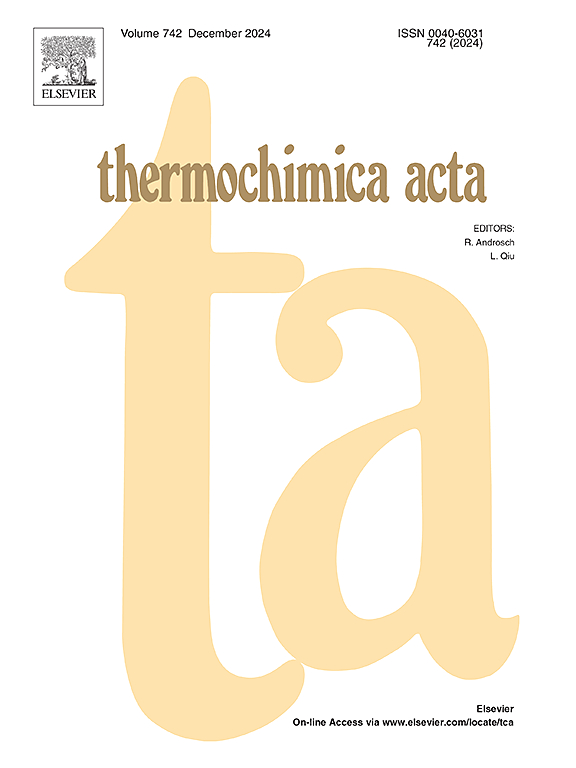Degradation pathways of Tadalafil: A thermoanalytical study.
IF 3.1
2区 化学
Q2 CHEMISTRY, ANALYTICAL
引用次数: 0
Abstract
Tadalafil (TAD) is one of the most marketed farmaceuticals against erectile dysfunction, due to its large use worldwide it is interesting to understand different aspects regarding this pharmaceutical active ingredient. Thus, in the present study, thermal behavior of TAD was investigated by simultaneous thermogravimetry-differential thermal analysis (TGA-DTA), differential scanning calorimetry (DSC), hot stage microscopy (HSM) and evolved gas analysis using thermogravimetry coupled to vibrational infrared spectroscopy (TGA-FTIR). In addition kinetics of thermal decomposition of the drug was evaluated by non-isothermal kinetic. In atmospheres of N2 and air, TAD, decomposed in different ways in N2 and air atmospheres. DSC curves presented an endothermic event related to the melting of the sample at Tonset = 576 K in the first heating, with no evidence of crystallization under the conditions used here. TGA-FTIR revealed that the thermal decomposition of TAD starts with releasing of 1,3-benzodioxole, carbon monoxide, and propyl isocyanate. The decomposition of the latter results in carbon dioxide and ammonia, which were identified in the gaseous phase and were not directly products from TAD, but by-products from propyl isocyanate. In the HSM, it was possible to observe the complete decomposition of TAD at 573 K, corroborating the results observed in TGA/DTG/DTA and DSC. According to these results, a thermal decomposition mechanism was proposed for TAD. Non-isothermal kinetic studies suggested two consecutive processes, which resulted in just one mass loss in the TGA curve: F1 (Ea = 174, logA = 12.3) and C1 (135 kJ mol−1), 8.3 (1 s−1).
他达拉非的降解途径:热分析研究。
他达拉非(TAD)是市面上最畅销的治疗勃起功能障碍的药物之一,由于其在世界范围内的广泛使用,了解这种药物活性成分的不同方面是很有趣的。因此,在本研究中,通过热重-差热分析(TGA-DTA)、差示扫描量热法(DSC)、热级显微镜(HSM)和热重-振动红外光谱(TGA-FTIR)结合的演化气分析来研究TAD的热行为。另外,用非等温动力学评价了药物的热分解动力学。在N2和空气气氛中,TAD在N2和空气气氛中分解方式不同。DSC曲线显示了与样品在Tonset = 576 K时第一次加热时熔化有关的吸热事件,在这里使用的条件下没有结晶的证据。热重-红外光谱分析表明,TAD的热分解首先释放1,3-苯二酚、一氧化碳和异氰酸丙酯。后者的分解产生二氧化碳和氨,它们在气相中被识别出来,不是TAD的直接产物,而是异氰酸丙酯的副产物。在HSM中,可以观察到TAD在573k时完全分解,证实了TGA/DTG/DTA和DSC的结果。根据这些结果,提出了TAD的热分解机理。非等温动力学研究表明,两个连续的过程只导致TGA曲线上的一次质量损失:F1 (Ea = 174, logA = 12.3)和C1 (135 kJ mol−1),8.3 (1 s−1)。
本文章由计算机程序翻译,如有差异,请以英文原文为准。
求助全文
约1分钟内获得全文
求助全文
来源期刊

Thermochimica Acta
化学-分析化学
CiteScore
6.50
自引率
8.60%
发文量
210
审稿时长
40 days
期刊介绍:
Thermochimica Acta publishes original research contributions covering all aspects of thermoanalytical and calorimetric methods and their application to experimental chemistry, physics, biology and engineering. The journal aims to span the whole range from fundamental research to practical application.
The journal focuses on the research that advances physical and analytical science of thermal phenomena. Therefore, the manuscripts are expected to provide important insights into the thermal phenomena studied or to propose significant improvements of analytical or computational techniques employed in thermal studies. Manuscripts that report the results of routine thermal measurements are not suitable for publication in Thermochimica Acta.
The journal particularly welcomes papers from newly emerging areas as well as from the traditional strength areas:
- New and improved instrumentation and methods
- Thermal properties and behavior of materials
- Kinetics of thermally stimulated processes
 求助内容:
求助内容: 应助结果提醒方式:
应助结果提醒方式:


